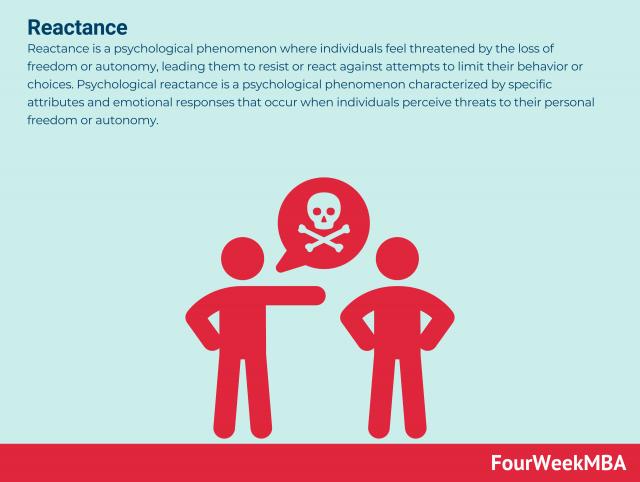Reactance is a psychological phenomenon where individuals feel threatened by the loss of freedom or autonomy, leading them to resist or react against attempts to limit their behavior or choices. Psychological Reactance is a psychological phenomenon characterized by specific attributes and emotional responses that occur when individuals perceive threats to their personal freedom or autonomy.
Characteristics
- Psychological Reactance: Reactance is an emotional and cognitive reaction that arises when individuals perceive their freedom of choice or action is being constrained or threatened. It is a natural response to efforts to limit one’s autonomy.
- Rebellious Behavior: Reactance can manifest as defiant or oppositional behavior, where individuals actively resist or push back against perceived restrictions, rules, or authority figures.
- Emotional Intensity: Individuals experiencing reactance often have strong emotional responses, which can include feelings of anger, frustration, resentment, or defiance. These emotions are driven by the perceived threat to their freedom.
Use Cases
Understanding and addressing reactance is relevant in various contexts where influencing behavior or decision-making is a key objective.
- Marketing and Advertising: In marketing and advertising, recognizing reactance helps marketers avoid pushy or manipulative tactics that can trigger resistance in consumers. This understanding allows for more effective and ethical persuasion strategies.
- Parenting and Education: Reactance awareness can guide educators and parents in providing choices and autonomy to children. By respecting children’s autonomy to a certain extent, educators and parents can foster a positive learning and developmental environment.
- Health Behavior Change: In healthcare, considering reactance can improve patient compliance and adherence to treatments or health interventions. Health professionals can take a more patient-centered approach to avoid triggering resistance.
Benefits
Acknowledging and addressing reactance offers several potential benefits in terms of individual autonomy and effective communication.
- Autonomy Promotion: Recognizing reactance allows individuals to maintain a sense of control over their decisions and actions, promoting their autonomy and independence.
- Avoiding Backfire: Awareness of reactance helps individuals and organizations avoid counterproductive outcomes when attempting to influence behavior. Overly coercive or restrictive measures can lead to resistance and backlash.
- Persuasion Strategies: By accounting for reactance, communicators can tailor their messages and approaches more effectively, increasing the likelihood of successfully influencing attitudes or behavior.
Challenges
Despite its benefits, addressing reactance presents certain challenges and considerations.
- Balancing Freedom and Control: Navigating the fine line between allowing autonomy and imposing necessary restrictions can be challenging, particularly in situations where safety or compliance is critical.
- Resistance to Change: Reactance can hinder the acceptance of new ideas, policies, or interventions, making it challenging to implement changes, even when they are in the best interest of individuals or organizations.
- Understanding Triggers: Identifying the specific triggers that evoke reactance in different individuals can be challenging, as reactance responses can vary widely based on personal values, beliefs, and experiences.
Examples
Examples of reactance highlight how this psychological phenomenon can manifest in various situations.
- Marketing Campaigns: Aggressive sales tactics or manipulative marketing strategies that attempt to pressure consumers into making a purchase may trigger reactance. Consumers may resist the sales pitch and become less likely to buy the product.
- Political Movements: Attempts by governments or authorities to impose restrictions on civil liberties or freedom of speech can lead to reactance among citizens. This can result in protests, demonstrations, or opposition to such measures.
- Parent-Child Relationships: Overly controlling or authoritarian parenting styles that limit a child’s autonomy and choices can evoke reactance in children. They may rebel against strict rules or seek more independence.
Reactance: Key Highlights
- Definition: Reactance is a psychological phenomenon where individuals resist or react against attempts to limit their behavior or choices, due to a perceived threat to their freedom.
- Characteristics:
- Psychological Reactance: Emotional reaction to perceived threats to personal freedom.
- Rebellious Behavior: Manifests as defiance or opposition to authority or rules.
- Emotional Intensity: Strong emotions like anger or frustration can arise.
- Use Cases:
- Marketing and Advertising: Understanding reactance helps avoid pushy tactics that trigger resistance in consumers.
- Parenting and Education: Reactance awareness guides educators and parents in providing choices and autonomy.
- Health Behavior Change: Considering reactance improves patient compliance with treatments.
- Benefits:
- Autonomy Promotion: Acknowledging reactance allows individuals to maintain control over decisions.
- Avoiding Backfire: Awareness prevents counterproductive outcomes when influencing behavior.
- Persuasion Strategies: By accounting for reactance, communicators tailor messages effectively.
- Challenges:
- Balancing Freedom and Control: Navigating the line between autonomy and restrictions.
- Resistance to Change: Reactance hinders acceptance of new ideas or policies.
- Understanding Triggers: Identifying reactance triggers in different individuals can be challenging.
- Examples:
- Marketing Campaigns: Aggressive sales tactics trigger reactance in consumers.
- Political Movements: Restrictions on civil liberties lead to reactance and protests.
- Parent-Child Relationships: Overly controlling parenting styles evoke reactance in children.
Connected Thinking Frameworks
Convergent vs. Divergent Thinking
Critical Thinking
Biases
Second-Order Thinking
Lateral Thinking
Bounded Rationality
Dunning-Kruger Effect
Occam’s Razor
Lindy Effect
Antifragility
Systems Thinking
Vertical Thinking
Maslow’s Hammer
Peter Principle
Straw Man Fallacy
Streisand Effect
Heuristic
Recognition Heuristic

